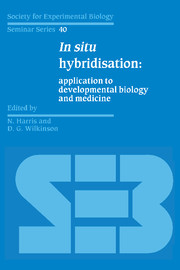Book contents
- Frontmatter
- Contents
- List of contributors
- Preface
- Non-radioisotopic labels for in situ hybridisation histochemistry: a histochemist's view.
- Use of haptenised nucleic acid probes in fluorescent in situ hybridisation
- The use of complementary RNA probes for the identification and localisation of peptide messenger RNA in the diffuse neuroendocrine system
- Contributions of the spatial analysis of gene expression to the study of sea urchin development
- Advantages and limitations of in situ hybridisation as exemplified by the molecular genetic analysis of Drosophila development
- The use of in situ hybridisation to study the localisation of maternal mRNAs during Xenopus oogenesis
- In situ hybridisation in the analysis of genes with potential roles in mouse embryogenesis
- Evolution of algal plastids from eukaryotic endosymbionts
- Localisation of expression of male flower-specific genes from maize by in situ hybridisation
- Tissue preparation techniques for in situ hybridisation studies of storage-protein gene expression during pea seed development
- Investigation of gene expression during plant gametogenesis by in situ hybridisation
- Sexing the human conceptus by in situ hybridisation
- Non-isotopic in situ hybridisation in human pathology
- The demonstration of viral DNA in human tissues by in situ DNA hybridisation
- Index
The use of complementary RNA probes for the identification and localisation of peptide messenger RNA in the diffuse neuroendocrine system
Published online by Cambridge University Press: 04 August 2010
- Frontmatter
- Contents
- List of contributors
- Preface
- Non-radioisotopic labels for in situ hybridisation histochemistry: a histochemist's view.
- Use of haptenised nucleic acid probes in fluorescent in situ hybridisation
- The use of complementary RNA probes for the identification and localisation of peptide messenger RNA in the diffuse neuroendocrine system
- Contributions of the spatial analysis of gene expression to the study of sea urchin development
- Advantages and limitations of in situ hybridisation as exemplified by the molecular genetic analysis of Drosophila development
- The use of in situ hybridisation to study the localisation of maternal mRNAs during Xenopus oogenesis
- In situ hybridisation in the analysis of genes with potential roles in mouse embryogenesis
- Evolution of algal plastids from eukaryotic endosymbionts
- Localisation of expression of male flower-specific genes from maize by in situ hybridisation
- Tissue preparation techniques for in situ hybridisation studies of storage-protein gene expression during pea seed development
- Investigation of gene expression during plant gametogenesis by in situ hybridisation
- Sexing the human conceptus by in situ hybridisation
- Non-isotopic in situ hybridisation in human pathology
- The demonstration of viral DNA in human tissues by in situ DNA hybridisation
- Index
Summary
Introduction
The introduction of in situ hybridisation for the localisation of specific peptide mRNAs at the site of synthesis is a useful adjunct to immunocytochemistry and has been used here to provide some answers concerning the expression of peptide mRNAs in the diffuse neuroendocrine system. Complementary ribonucleotide probes were transcribed from subcloned inserts of cDNAs encoding specific peptide sequences. The peptides studied include the neuropeptides calcitonin gene-related peptide (CGRP), substance P, vasoactive intestinal polypeptide (VIP) and neuropeptide Y (NPY) as examples of neurally borne substances in the central and peripheral nervous system and atrial natriuretic peptide (ANP) and prolactin as examples of circulating hormones produced by endocrine cells. These examples emphasise the value of in situ hybridisation by elucidating sites of peptide mRNA production in the neuroendocrine system and their change in different physiological conditions.
It is now widely accepted that regulatory peptides are present in the typical endocrine cells of the ‘diffuse endocrine system’ described by Feyrter (1938) or the APUD (amine or amine precursor uptake and decarboxylation) system of Pearse (1969) as well as in nerves of the central and peripheral nervous system. This newly recognised ‘diffuse neuroendocrine system’ is thus characterised by the synthesis and release of a number of regulatory peptides which mediate the actions of these cells in a number of varied ways. Some act as circulating hormones, while others have a more restricted effect, acting only in the region of their release from endocrine or neuronal cells as potent modulators, neurotransmitters or long-term growth factors.
- Type
- Chapter
- Information
- In Situ HybridisationApplication to Developmental Biology and Medicine, pp. 43 - 68Publisher: Cambridge University PressPrint publication year: 1990
- 1
- Cited by



